Skin Traction - Lower Extremity
Buck's skin traction is widely used in the lower limb for femoral fractures,
lower backache, acetabular and hip fractures. Skin traction rarely reduces
a fracture, but reduces pain and maintains length in fractures.
Method
The skin is prepared and shaved -it must be dry.
Friar's balsam may be used to improve adhesion. The commercially
available strapping is applied to the skin and wound on with an overlapping
layer of bandage. The bandage should not extend above the level of the
fracture.
Dangers of Skin Traction
- Distal Oedema
- Vascular obstruction
- Peroneal nerve palsy
- Skin Necrosis over bony prominence's
Avoid complications resist
the temptation of trying to improve adhesion by wrapping the bandages
more tightly. If the tapes slip rather use skeletal traction
if possible (not a child)
Gallows Traction
This is used in infants and children with femoral fractures.

Both the fractured and
the well femur are placed in skin traction and the infant is suspended
by these from a special frame. Vascular compromise is the biggest danger.
Check the circulation twice daily. The buttocks should be just off the
bed.
Femur Fractures in older children
Older children with femur fractures can be treated with skin traction
in a Thomas splint. Unlike the adult the knee must be kept straight
in the Thomas Splint.
|
Skin traction in a Thomas
Splint. |
 |
The ring of the Thomas splint must allow two finger clearance on all
sides- try it on the well leg for fit before applying. The skin strapping
is applied and the Thomas Splint fitted. The ropes from the strapping
are tied to the end of the Thomas splint. The outer one is passed under
the Thomas splint bar and the inner one Over. This rotates the
foot internally. The limb is rested on three flannel strips secured
by safety pins. The Master sling is the flannel strip directly
distal to the fracture.
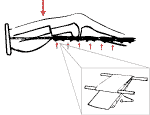 |
|
Slings of flannel 150mm wide are positioned down
the length of the Thomas splint. The Master sling should be just
distal to the fracture, allowing the proximal fragment to reduce
under gravity. |
These slings can be adjusted so that he fracture ends align in the
vertical plane. The longitudinal traction needs adjustment every
day in the first week. The knot at the end of the Thomas splint
is loosened and the slack taken up. The quality of reduction is confirmed
by regular X rays.
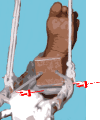 |
"Inner
Under
Outer Over"
for counter-torque |
The Thomas splint is suspended from a Balkan Frame. This is
a frame attached to the bed. To allow the patient to move about in
the bed e.g. to use a bed pan. The limb with the Thomas splint is
suspended from the top of the Thomas Splint by means of a counter
weight. The longitudinal traction exerts pressure on the groin and
a further weight is placed over a pulley on the balkan frame. It is
in line with the long axis of the limb at the foot of the bed. This
counter acts the reactive force on the groin generated by the skin
traction.
Overgrowth Slight overlapping (up to 2 cm) of the bones is acceptable,
as the fracture stimulates overgrowth in the local growth plates.
End-on-end reduction, as with plating and other internal fixations,
sometimes results in the injured limb growing more then the uninjured.
Most of the overgrowth takes place in the first year after fracture.
Femur Fractures in Adults
This requires a skeletal pin.
At Tygerberg hospital the Denham pin is commonly used. This has a
threaded middle portion that keeps it in the tibia. For femoral fractures
the Denham Pin through the proximal tibia. Always insert from lateral
to medial in the proximal tibia, as the peroneal nerve needs to be missed
and the site of exit is unpredictable. On some occasions a distal femoral
site, or even the calcaneus may be used.
 |
| Site for prox.
tibial Denham pin 2.5 cm inferior and distal to tibial tubercle |
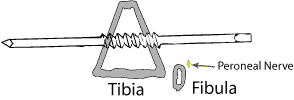
 |
Thomas Traction -Adult
Click to see annotated
larger image |
A Thomas splint, (check it fits, by trying on the well leg) is applied.
Three flannel slings are secured by safety pins under the thigh. The
"Master splint" is the one under the fracture. The correct tension on
this sling will align the fracture in the lateral plane. The knee can
be flexed by using a Pearson flexion splint attached to the Thomas splint
at the knee. The desired knee flexion can be maintained by a rope at
its end leading from the Thomas splint to the Pearson attachment. Ropes
from the Denham pin can either be tied distally to the Thomas splint
(static traction) or they can be led over a pulley on the end of the
Balkan frame (dynamic Traction) In either case start with 7 kg
( or 10% body weight) in the long axis of the femur. This opposes the
pull of the thigh muscles. As with the child, the traction is made balanced
by a system of pulleys on the horizontal limb of the Balkan frame to
allow the patient to move his limb. A "monkey chain" hung above the
arms also allows the patient to transfer himself onto a bedpan. as he
moves in the bed.
Alignment of Thomas Splint
The Thomas splint must be aligned by pointing the Balkan frame in
the direction of the proximal fragment.
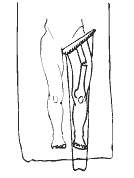 |
Displacement of a femur fracture |
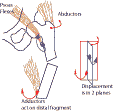 |
Muscles causing the displacement |
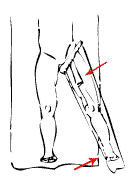 |
How to align the Thomas Splint.
Also raise foot-end to provide flexion |
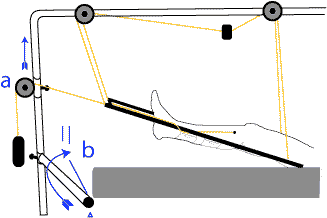 |
| Balkan Frame Adjustment: For flexion,
raise pulley (a). For abduction, swing foot-end of balkan wide of
bed (b) |
Displacement - Proximal femur fracture
- Prox. Femur - Flexion
- Prox. Femur - Abduction
- Align frame - Flexion & Abduction
Mid-shaft fractures remain relatively un displaced as the proximal and
distal muscles balance.
Distal femur fracture displacement
- Posterior angulation - pull of gastrocnemius
- Solution - flex the knee as far as possible
Bed Blocks
Bed Blocks must be placed under the foot end of the bed with all the
above types of traction. Raising the foot of the bed a few centimeters
provides a counter force to prevent the patient being pulled distally
down the bed by the longitudinal traction.
|